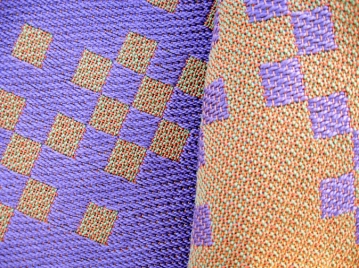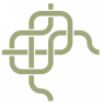I learned that lampas is a type of double weave with many possible variations. There are variations that have some areas with “pockets” between layers and variations with “tied” layers that have no pockets, and different yarn sizes can play an important role in lampas. My experience with this weave comes from studying Alice Schlein’s enlightening e-monograph, Lampas for Shaft Looms. This monograph is a real treasure, covering just about everything you always wanted to know about lampas including block, straight, and networked threadings, even pick-up lampas, and much more. I was searching for a new challenge and this was it!
I started out by weaving a few basic “easy” samples of a 2:1 warp ratio of plain weave in both the primary and secondary cloth. Then I tried something a little more challenging and came up with this:
My design for this pillow began with a profile draft of 4 threading and treadling blocks:
After inspecting all my samples, I decided to use the following specs to weave tied lampas cloth to make the pillow: warp ratio of 2:1 plain weave for the primary warp and 3-end straight twill for the secondary warp. There are no pockets at all in the tied version so the cloth is more stable. I created the draft below (front view for my rising shed treadle loom, using 11 shafts and 9 treadles) that shows two repeats of each threading block (9 units per block) and one repeat of each treadling block (12 units per block). For this project I repeated each threading block two times and each treadling block also two times, manually substituting the corresponding blocks in the profile draft. The tie-up shows a skeleton tie-up and 2 treadles have to be pressed at the same time for each weft shot. I wove it this way and it was actually a lot of fun! In Fiberworks you can use block substitution to automatically generate a thread-by-thread draft of several types of lampas from a profile draft, and you can choose a normal, skeleton, or liftplan tie-up. But none of the types of lampas listed was what I wanted so I did the substitutions manually.
A few notes about how I wove the cloth for the pillow: primary warp – 10/2 light green perle cotton, secondary warp – 40/3 orange quilting cotton, primary weft – 20/2 (2 strands together) beige unmercerized cotton, secondary weft – 5/2 coral pink, purple, and yellow perle cotton; warp ends per inch – 30 (3 per dent in 10-dent reed, 2 primary and 1 secondary per dent). While the coral pink weft is loom-controlled, the purple and yellow wefts are inlaid by hand. The cloth was finished by hand washing, air drying, and steam ironing. The finished cloth is about 26 inches long and 21 inches wide. The close-up photo of the pillow shows the pattern exactly as it appeared from the front of the loom as I was weaving while the pillow on the sofa is on its side so the pattern is turned.
The photo below is a close-up of a lampas table runner that I designed and wove showing front and back. I like both sides equally and use it either way. It’s also 2:1 tied plain weave and 3-end straight twill with the same threading but different tie-up and treadling than the pillow.
Next are two photos, front and back of the same sample, illustrating 2:1 plain weave in both the primary and secondary cloth. The bottom half of each photo shows tied lampas and the top half of each shows untied lampas. I find the subtle differences very interesting.
I was delighted when I read in Alice’s monograph that Theo Moorman’s inlay weavings can be considered to be lampas because I explored and wrote a post about the Moorman Inlay Technique some time ago. Here’s a photo of something I found in my stash of things I wove long ago – a little bag with fabric strips used as the inlay weft:
This has been another enjoyable and exhilarating weaving experience!
Happy New Year 2018!
UPDATE November, 2018: I developed an article from this blog post that is published in the October 2018 issue of the Complex Weavers Journal, “Lampas and Moorman Inlay Pillow.” You can download the wif files of the profile draft and the thread-by-thread draft of the four blocks from the Complex Weavers website at this link.







